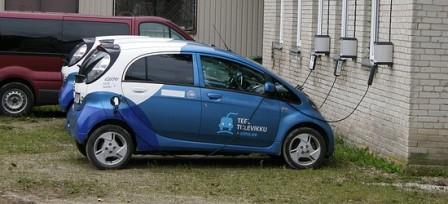E-Vehicles: A blessing in disguise for thermal power, especially coal?

India is on a cusp of a revolutionary change in the
automobile landscape which will shape the demand for electricity in more ways
than one in future.
As battery powered vehicles replace oil ones in the
next two decades or so, the demand for electricity will surge immensely. Will renewables alone
find the power to fuel those vehicles, or do we also need conventional sources
to tackle this?
The Paris agreement to which India is a signatory
mandates the country to reduce its carbon dioxide emissions to keep the global
average temperatures from rising above 1.5°C. This and the growing concerns for
a cleaner environment may have resulted in the government pushing the fifth
gear for electric vehicles.
It is firmly believed that electric vehicles
charged with electricity from renewable sources such as solar energy can bring
down the emissions of greenhouse gases and air pollutants while enhancing a
decarbonised transport system.
As per Coal
Vision 2030 document, a study commissioned by Coal India, electricity vehicles
can result in an incremental demand for power of nearly 160 billion units
(bKWh) by 2030. The flipside of such high demand is that it will work
positively for coal-operated power sector unless renewables don’t take deep root
by then.
World Economic Forum has also documented that India will have an
all-electric fleet by 2030. Piyush Goyal, who was earlier Minister of State for
Power, Coal, New and Renewable Energy, had said that India will have only
electric vehicles by then. Inference perhaps was that the production of petrol
and diesel vehicles will most likely be discontinued thereafter.
Society of Indian Automobile Manufacturers in its
December 2017 report titled Adopting Pure Electric Vehicles: Key Policy
Enablers has stated that 40% of new vehicle sales in the country will
be purely electric vehicles by 2030. The report specifies that 60% of the new
vehicle sales in the country will have greener technologies such as hybrids and
other alternative fuels.
So how do we charge these battery driven vehicles
and through which source?
“This is an important question which we tend to
either overlook or haven’t taken into consideration. You need base load to keep
the batteries running and this can come only from conventional sources such as
coal as how the situation currently is,” a sector analyst said.
“You need to keep the electric car plugged in the
whole night and this is likely to increase power consumption by 50% or more
resulting in peak electricity demand jump. It is undeniable that vehicle owners
will be plugging in the evenings or at night as in day time they would use it
for other purposes. Every time a vehicle goes to power up it will have to
depend on coal power more often than not since renewables won’t work in the
night.”
Industry sources point out that this will also
reverse the trend for falling demand for electricity which ails the power
sector often. Power sector will no longer be bogged down for lack of demand.
Upticks in power sale will boost the financial prospects of stressed projects
in power sector.
E-vehicles are still at a nascent stage in India
with an estimated 4 lakh electric two-wheelers and a few thousand cars plying
on the roads. However, electric vehicles have the potential to grow to more
than 5% of annual vehicle sales in the coming years as per the Coal Vision 2030
document. The document also points out that the Faster Adoption and
Manufacturing of Electric Vehicles scheme envisages a population of
15-16 million electric vehicles in India within the next two years itself.
It is easier to charge a hundred thousand
e-vehicles spread across the length and breadth of the country in 2018 but
imagine the situation in 2030 when over 300 million vehicles need to be charged
every day, day and night and anywhere in the country. The power these vehicles
will consume needs to be generated first and this demand cannot be met by solar
power or any other renewable source that easily.
As India moves forward with its e-vehicle adoption
it will become important to ensure that electric cars use electricity which is produced
from renewable sources of energy alone. Doing so is a challenge unless storage
technologies improve tremendously.
These are challenges and how the country is bracing
itself up to meet them is perhaps only a matter of time.
Also distance is a factor as the battery needs to
be recharged after the vehicle travels a certain distance. Vehicle
manufacturers have made significant progress in dealing with this. A recent Guardian
report said about five members of a Telsa club making a claim of having
traveled 670 miles on a single charge.
(The author is a Delhi-based
journalist. He can be reached at prasad.n@indoen.com)
- India’s climate finance blueprint: A snail’s pace or a fast gallop?
- India imports 2.6 Mt steam coal, 0.8 Mt coking coal (23–29 Mar)
- India boosts energy security with record coal production
- Indian Government lifts restrictions on coal purchases for power plants
- India imports 4 Mt steam coal, 1.4 Mt coking coal (16–22 Mar)
- India’s solar energy revolution: A path to 500 GW by 2030 and beyond
- Powering the grid: The impact of electric vehicles on India’s energy infrastructure
- India imports 2.9 Mt steam coal, 1.3 Mt coking coal (09–15 Mar)
- Strategic Pathways For India’s Green Mobility
- India’s rising coal use: Balancing energy demand and sustainability goals